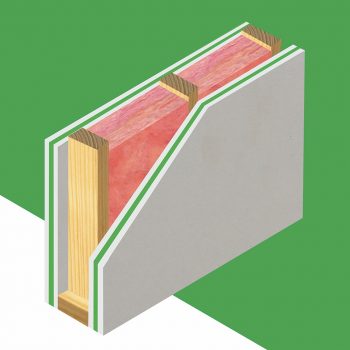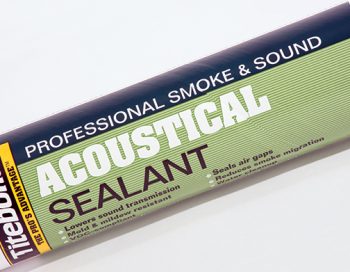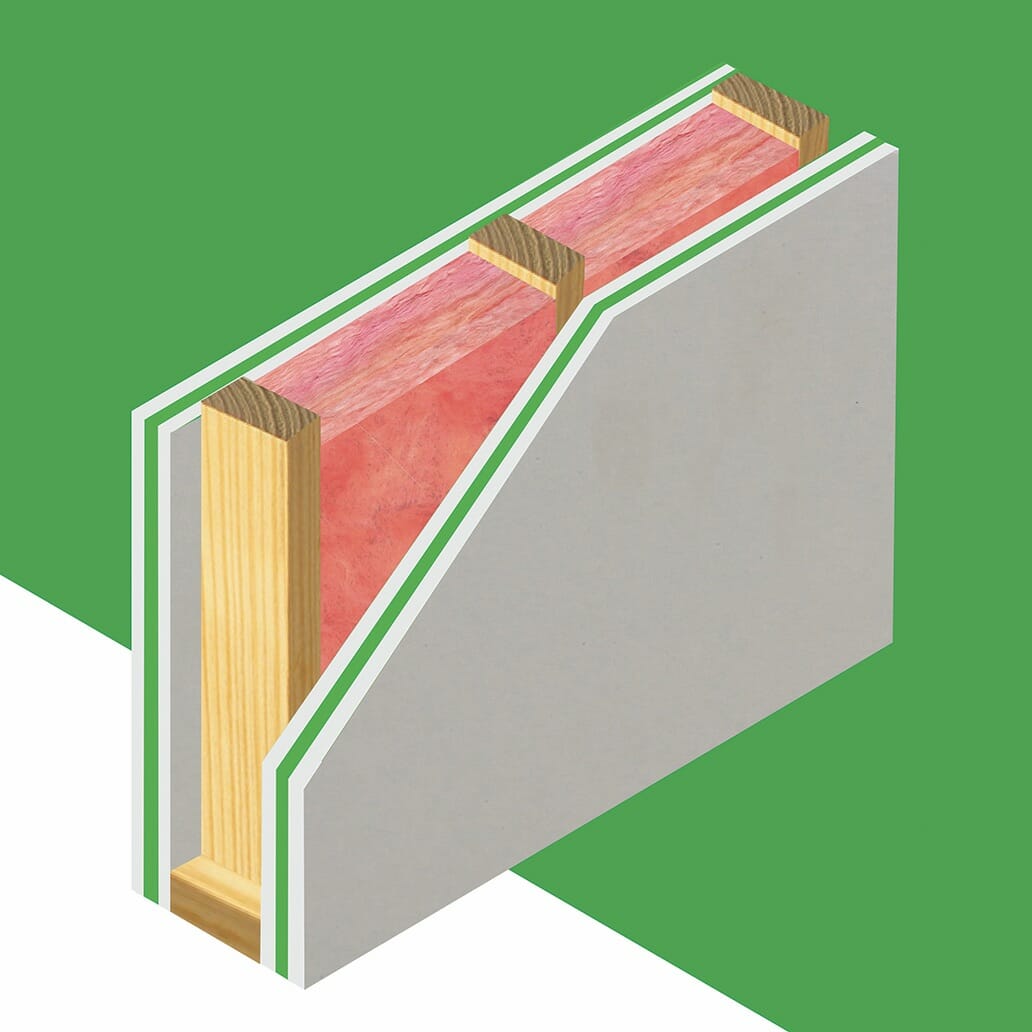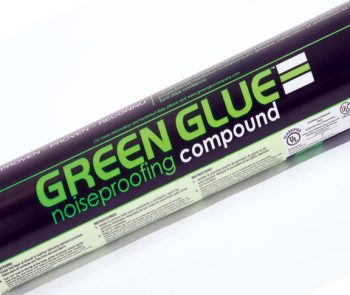Soundproofing a Wall

Soundproofing a room or an office is all about keeping unwanted noise out and keeping sound inside. Like thermal insulation, soundproofing a space means structurally isolating it – separating the outside from the inside.
There are any numbers of reasons why you may want to soundproof a room. You might require professional confidentiality – such as in a lawyer’s or doctor’s office. Perhaps you want
to create an entertainment room in your home, or maybe you’d like to seal the wall of sound in your teenager’s bedroom as they blast their tunes.
In any scenario, you can structurally and acoustically isolate rooms by soundproofing internal walls. The goal is to increase the mass and the density of a wall, and ensure that all gaps are properly sealed. Below, we’ll show you at least one method of soundproofing an internal wall.
Soundproofing an Internal Wall
We will assume that you have already completed a wall frame using standard 2″×4″ studs spaced on 2′ centers.
Determine the square footage of drywall you will need based on the measurements of the wall you’ll be soundproofing.
Note: you’ll need a double-order of the 5/8″ drywall.
A Few Notes on Soundproofing Materials
Soundproofing Insulation
For great sound blocking insulation, we recommend our UltraTouch™ Denim Insulation. It’s made of 80% post-consumer recycled denim, it doesn’t itch, and it’s easy to handle. It’s also a Class-A building material which offers maximum R- and high NRC values to reduce noise.
Another option for wall insulation is our CFAB Cellulose Insulation Soundproofing. A first of its kind in our industry, we make our CFAB panels with a cellulose-based material consisting of 65-75% recycled content. CFAB cellulose products also represent a very highly environmentally-responsible solution for acoustical materials.
Sound Blocking Gypsum Board
If you’re seeking the highest value on your soundproofing investment, we also recommend that you use our SOUNDBREAK® XP® Acoustically Enhanced Gypsum Board. This innovative gypsum drywall achieves high STC ratings and lets you construct walls that are thinner, more cost effective, and very reliable. In addition to deadening sound, it’s also resistant to mold, mildew, and moisture.
Inter-Layer Sound Blocking
In this application, you’ll be creating a double layer of drywall, so we also recommend that you use Green Glue, sandwiched between the two layers of drywall. It’s easy to apply with a standard caulking gun, and it delivers additional damping levels as high as 30%.
Acoustical Gap Sealant
 Finally, every system is only as strong as its weakest link, so make sure that you completely seal all gaps at the edges of your new wall – walls, floors, and ceilings included. Did you know that even a 1 percent gap in a wall system can decrease its sound blocking ability by as much as 50 percent?
Finally, every system is only as strong as its weakest link, so make sure that you completely seal all gaps at the edges of your new wall – walls, floors, and ceilings included. Did you know that even a 1 percent gap in a wall system can decrease its sound blocking ability by as much as 50 percent?
We have two products which you can use for this purpose: AcoustiSeal™ Acoustical Sealant and GREENchoice™ Acoustical Sound Sealant. Each of these products is easy to apply with a standard caulking gun, and contribute to higher STC ratings for your wall(s).
Materials and Equipment
- 1/2″ SOUNDBREAK® XP® Acoustically Enhanced Gypsum Board – sufficient to cover one side of wall
- 5/8″ SOUNDBREAK® XP® Acoustically Enhanced Gypsum Board – double amount for double layer
- 3″ UltraTouch™ Denim Insulation, or
- 2″ CFAB Cellulose Insulation Soundproofing – sufficient to cover square footage of wall
- Green Glue: 2 tubes per 8′ sheet of drywall, or 2 ½ tubes per 10′ sheet of drywall
- AcoustiSeal™ Acoustical Sealant or GREENchoice™ Acoustical Sound Sealant
- 1-1/2” Drywall Screws
- 2-1/2″ Drywall Screws
Standard carpentry resources: measuring/marking, drywall saw, power drill, drywall lift, caulking gun et
Installing Drywall On the First Side of the Wall
1. Install 1/2″ SOUNDBREAK® XP® Acoustically Enhanced Gypsum Board on the first side of your wall frame, using 1½” drywall screws.
Installing Insulation
1. Install 3″ UltraTouch™ Denim Insulation or 2″ CFAB Cellulose Insulation Soundproofing.
2. Cut the insulation so that it fits snugly within the 2″×4″ wall frame leaving no gaps between the wall studs and joints where vertical pieces meet.
Applying the First Layer of Drywall on the Second Side
1. On back side of the wall, install a layer of 5/8″ SOUNDBREAK® XP® Acoustically Enhanced Gypsum Board.
NOTE: Leave a 1/4″ gap around the entire perimeter of the wall.
2. Use your acoustical sealant to seal the entire 1/4″ gap – including the ceiling and the floor as well as the vertical edges of the wall.
Applying the Second Layer of Drywall
1. Once you’ve measured and cut your drywall, generously apply Green Glue to the backside. 

NOTE: Use 2 tubes per standard 8′ sheet of drywall – or 2-1/2 tubes per 10′ sheet of drywall
2. Screw in the second layer of drywall using 2-1/2″ drywall screws (you’ll have to penetrate two layers of 5/8″ drywall which = 1-1/4″). Remember to stagger the seams when you apply the second layer of 5/8″ gypsum board on top of the first. This will prevent any leakage due to doubled-up seams.
3. Again, use the acoustical sealant to seal the entire 1/4″ gap – including the ceiling and the floor as well as the vertical edges of the wall.
NOTE: The 1/4″ gap around the perimeter of the wall, once sealed, will de-couple the whole wall from the frame, thereby “isolating” it.
4. Finally, tape, sand, prime, and paint your new wall.
Conclusion
While you could get even more sophisticated in terms of building fully de-coupled walls, this method will provide you incredible soundproofing quality for your investment.
Of course, there are many strategies for every budget, so for more information and a wealth of resources, please visit https://www.acousticalsurfaces.com/.



